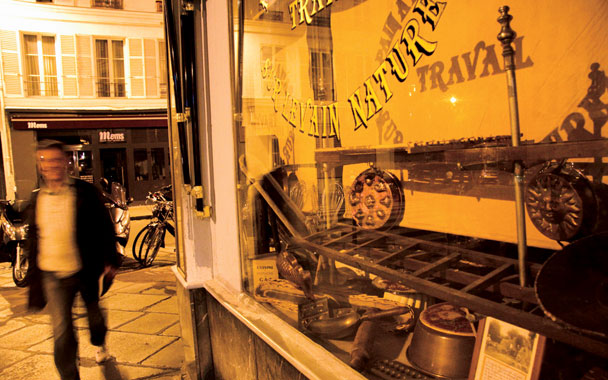Think of this area as a developing photograph, an image progressing from blurred first impression to materialization in detail. Until very recently, this neighborhood was one of the more anonymous parts of Paris—rootless and slightly forlorn, thanks to the fact that its main business has always been getting people in and out of town, through either the Gare du Nord or the Gare de l’Est. It doesn’t help that the grid of streets here is slashed crosswise by two pounding arteries (the Boulevard de Magenta and the Rue La Fayette) whose sole purpose is whisking passengers between the stations and the rest of the city. That snapshot of indeterminacy has changed, though; today, the 10th has been reborn as one of the most dramatic neighborhoods in the city.
Good bones helped: The Canal Saint-Martin, a glorious 19th-century waterway, connects to the Seine through a path of leafy planes, poplars, and chestnuts, begging you to wander along its banks, catching some sun by day or lingering over a bottle of wine in the evening. It finally occurred to young hipsters how supremely desirable—not to mention how affordable—it might be to live beside a onetime working canal. This aquatic spine of the quartier began to gentrify a few years ago (it’s no longer such a bargain), but if you stroll down any of its side streets, you’ll still find one of the most unusual urban oases anywhere in the world.
The Rue du Château-d’Eau, for example, is the epicenter of African hairdressing, almost entirely lined with brightly colored barber shops and beauty parlors. But every now and then, something else sneaks in. Something like Globus France, a shop that sells charcuterie from Bosnia, Serbia, Croatia, Romania, Poland, and Hungary. On the Rue Cail, everything is Indian, including the wonderful vegetarian restaurant Krishna-Bhavan, tucked amid shops and clothing stores. The jewel of the Rue du Faubourg-Saint-Martin is the foppishly opulent Mairie du 10e Arrondissement, or town hall, a massive mock–Loire Valley château, finished in 1896, that rather comically lords it over the neighboring clutch of Turkish cafés. Nearby is the pedestrian Passage Brady, a glass-roofed 19th-century arcade that’s become a legendary destination for backpackers, stuffed as it is with cheap Indian and Pakistani restaurants. (Try Le Passage de Pondichéry.) Just a few blocks over, on the Rue de Marseille, branches of chic clothiers are sprouting up, and you’ll also find Du Pain et des Idées, one of the best new bakeries in Paris.
Generations of privileged Parisian brides have chosen their porcelain, stemware, and silver on the irresistibly named Rue de Paradis, where most of the major French crystal manufacturers had their showrooms. (It’s a convenient walk from the Gare de l’Est, which serves the province of Lorraine, where the crystal factories of Baccarat and Saint-Louis are still located.) Today most of the crystal showrooms have moved to more conventionally stylish precincts, but there’s still some great tabletop shopping in the area. At No. 18, you’ll find the stop-you-in-your-tracks-grandiose Magasins de Vente des Faïenceries de Choisy-le-Roi, the former showroom of the ceramic works that supplied the tiles for the Paris métro. Intended to broadcast the company’s savoir faire, the interior is elaborately decorated in an odd neoclassical theme complete with urns and busts.
Is it my imagination, or are the paving stones outside the Gare du Nord almost eternally damp, an avant-goût of life under gray northern skies? But there’s also grandeur here, in the facade of female statues, each representing a destination served (Amsterdam, Berlin, Warsaw), that look down from pedestals with goddess-like hauteur. Of course, Paris towers above them all. The Gare de l’Est, on the other hand, reflects Alsace’s Germanic aspect and quietly bristles with regional pride, as reflected by En Passant par la Lorraine, which sells Alsatian eaux-de-vie and eight-packs of boutique brewers suds.
Around the corner, the Rue des Récollets (punctuated by an unexpected breath of fresh air from the gardens of a medieval convent) leads to the Canal Saint-Martin, a hardscrabble precinct of workshops and small factories turned dreamy enclave of the city. Originally commissioned by Napoleon, the canal was built between 1805 and 1825 by engineer Pierre-Simon Girard, who had studied the hydraulics of the Nile during Napoleon’s Egyptian campaign. It became a major freight route into central Paris and commercialized what had been a relatively rural part of town beyond the city walls.




 Pinterest
Pinterest


